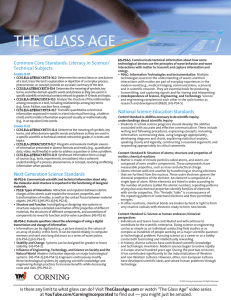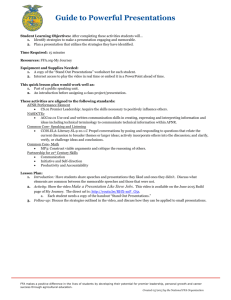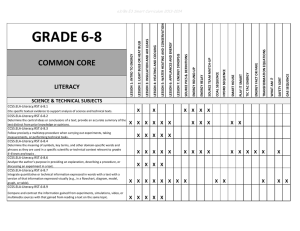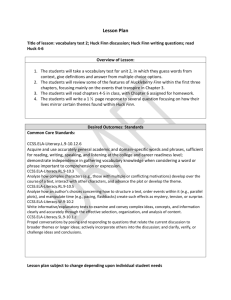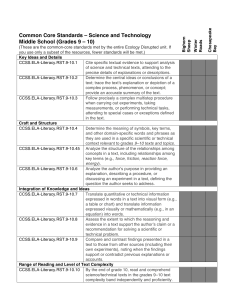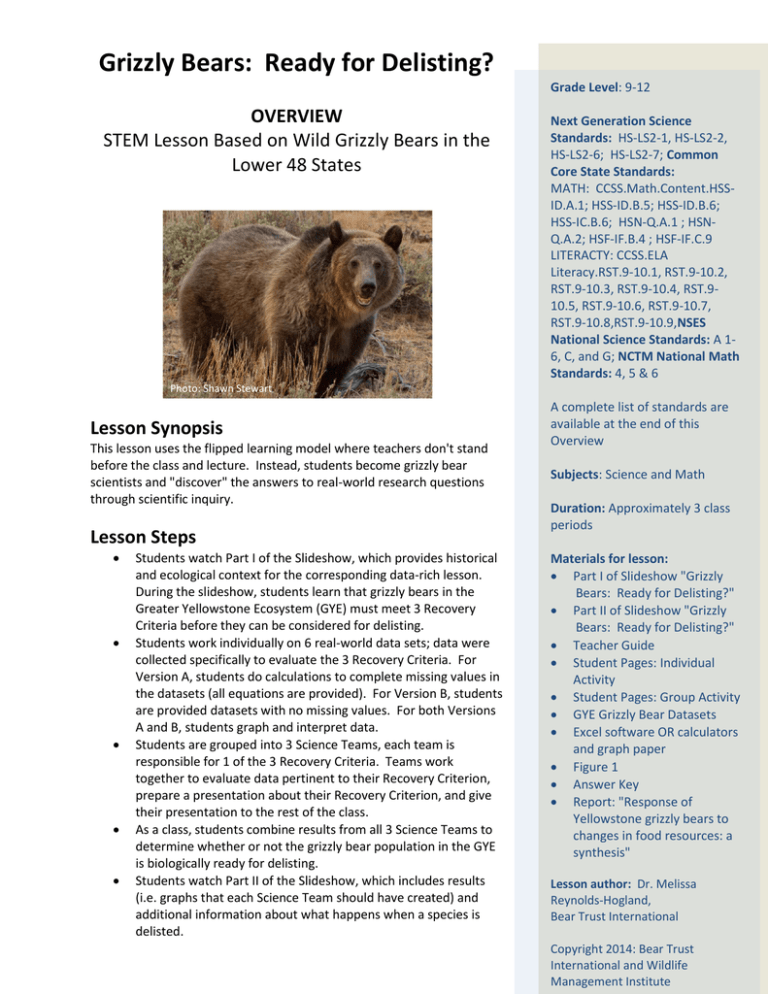
Grizzly Bears: Ready for Delisting?
Grade Level: 9-12
OVERVIEW
STEM Lesson Based on Wild Grizzly Bears in the
Lower 48 States
Next Generation Science
Standards: HS-LS2-1, HS-LS2-2,
HS-LS2-6; HS-LS2-7; Common
Core State Standards:
MATH: CCSS.Math.Content.HSSID.A.1; HSS-ID.B.5; HSS-ID.B.6;
HSS-IC.B.6; HSN-Q.A.1 ; HSNQ.A.2; HSF-IF.B.4 ; HSF-IF.C.9
LITERACTY: CCSS.ELA
Literacy.RST.9-10.1, RST.9-10.2,
RST.9-10.3, RST.9-10.4, RST.910.5, RST.9-10.6, RST.9-10.7,
RST.9-10.8,RST.9-10.9,NSES
National Science Standards: A 16, C, and G; NCTM National Math
Standards: 4, 5 & 6
Photo: Shawn Stewart
Lesson Synopsis
This lesson uses the flipped learning model where teachers don't stand
before the class and lecture. Instead, students become grizzly bear
scientists and "discover" the answers to real-world research questions
through scientific inquiry.
Lesson Steps
Students watch Part I of the Slideshow, which provides historical
and ecological context for the corresponding data-rich lesson.
During the slideshow, students learn that grizzly bears in the
Greater Yellowstone Ecosystem (GYE) must meet 3 Recovery
Criteria before they can be considered for delisting.
Students work individually on 6 real-world data sets; data were
collected specifically to evaluate the 3 Recovery Criteria. For
Version A, students do calculations to complete missing values in
the datasets (all equations are provided). For Version B, students
are provided datasets with no missing values. For both Versions
A and B, students graph and interpret data.
Students are grouped into 3 Science Teams, each team is
responsible for 1 of the 3 Recovery Criteria. Teams work
together to evaluate data pertinent to their Recovery Criterion,
prepare a presentation about their Recovery Criterion, and give
their presentation to the rest of the class.
As a class, students combine results from all 3 Science Teams to
determine whether or not the grizzly bear population in the GYE
is biologically ready for delisting.
Students watch Part II of the Slideshow, which includes results
(i.e. graphs that each Science Team should have created) and
additional information about what happens when a species is
delisted.
A complete list of standards are
available at the end of this
Overview
Subjects: Science and Math
Duration: Approximately 3 class
periods
Materials for lesson:
Part I of Slideshow "Grizzly
Bears: Ready for Delisting?"
Part II of Slideshow "Grizzly
Bears: Ready for Delisting?"
Teacher Guide
Student Pages: Individual
Activity
Student Pages: Group Activity
GYE Grizzly Bear Datasets
Excel software OR calculators
and graph paper
Figure 1
Answer Key
Report: "Response of
Yellowstone grizzly bears to
changes in food resources: a
synthesis"
Lesson author: Dr. Melissa
Reynolds-Hogland,
Bear Trust International
Copyright 2014: Bear Trust
International and Wildlife
Management Institute
Grizzly Bears: Ready for Delisting?
Written by Dr. Melissa-Reynolds Hogland/Bear Trust International
Printed by Bear Trust International
This lesson is provided at no charge to educators, youth, and the public thanks
to the generosity of the following sponsors:
Copyright © 2014 by Bear Trust International and Wildlife Management Institute. All rights reserved.
No part of this lesson may be reproduced or transmitted in any form or by any means without written
permission from Bear Trust International.
For the purpose of education, all materials for this lesson are available for free download on the Bear
Trust International website: www.beartrust.org
Grizzly Bears: Ready for Delisting? OVERVIEW Page 2
Next Generation Science Standards: High School
Performance Expectations:
HS-LS2-1: Use mathematical and/or computational representations to support explanations of factors
that affect carrying capacity of ecosystems at different scales
HS-LS2-2: Use mathematical representations to support and revise explanations based on evidence
about factors affecting biodiversity and populations in ecosystems of different scales
HS-LS2-6 : Evaluate claims, evidence, and reasoning that the complex interactions in ecosystems
maintain relatively consistent numbers and types of organisms in stable conditions, but changing
conditions may result in a new ecosystem
HS-LS2-7: Design, evaluate, and refine a solution for reducing the impacts of human activities on the
environment and biodiversity
Science and Engineering Practices:
Asking questions and Defining Problems
Developing and Using Models
Using Mathematics and Computational Thinking
Constructing Explanations and Designing Solutions
Engaging in Argument from Evidence
Disciplinary Core Ideas:
Interdependent Relationships in Ecosystems
Developing Possible Solutions
Crosscutting Concepts:
Cause and Effect
Stability and Change
Common Core State Standards: Math
CCSS.Math.Content.HSS-ID.A.1: Represent data with plots on the real number line (dot plots,
histograms, and box plots).
CCSS.Math.Content.HSS-ID.B.5: Summarize categorical data for two categories in two-way frequency
tables. Interpret relative frequencies in the context of the data (including joint, marginal, and
conditional relative frequencies). Recognize possible associations and trends in the data.
Grizzly Bears: Ready for Delisting? OVERVIEW Page 3
CCSS.Math.Content.HSS-ID.B.6: Represent data on two quantitative variables on a scatter plot, and
describe how the variables are related.
CCSS.Math.Content.HSS-IC.B.6: Evaluate reports based on data.
CCSS.Math.Content.HSN-Q.A.1: Use units as a way to understand problems and to guide the solution of
multi-step problems; choose and interpret units consistently in formulas; choose and interpret the scale
and the origin in graphs and data displays.
CCSS.Math.Content.HSN-Q.A.2: Define appropriate quantities for the purpose of descriptive modeling.
CCSS.Math.Content.HSF-IF.B.4: For a function that models a relationship between two quantities,
interpret key features of graphs and tables in terms of the quantities, and sketch graphs showing key
features given a verbal description of the relationship
CCSS.Math.Content.HSF-IF.C.9: Compare properties of two functions each represented in a different
way (algebraically, graphically, numerically in tables, or by verbal descriptions).
Common Core State Standard Connections: Literacy
CCSS.ELA-Literacy.RST.9-10.1: Cite specific textual evidence to support analysis of science and technical
texts, attending to the precise details of explanations or descriptions.
CCSS.ELA-Literacy.RST.9-10.2: Determine the central ideas or conclusions of a text; trace the text’s
explanation or depiction of a complex process, phenomenon, or concept; provide an accurate summary
of the text.
CCSS.ELA-Literacy.RST.9-10.3: Follow precisely a complex multistep procedure when carrying out
experiments, taking measurements, or performing technical tasks, attending to special cases or
exceptions defined in the text
CCSS.ELA-Literacy.RST.9-10.4: Determine the meaning of symbols, key terms, and other domainspecific words and phrases as they are used in a specific scientific or technical context
CCSS.ELA-Literacy.RST.9-10.5: Analyze the structure of the relationships among concepts in a text,
including relationships among key terms (e.g., force, friction, reaction force, energy).
CCSS.ELA-Literacy.RST.9-10.6: Analyze the author’s purpose in providing an explanation, describing a
procedure, or discussing an experiment in a text, defining the question the author seeks to address.
CCSS.ELA-Literacy.RST.9-10.7: Translate quantitative or technical information expressed in words in a
text into visual form (e.g., a table or chart) and translate information expressed visually or
mathematically (e.g., in an equation) into words.
CCSS.ELA-Literacy.RST.9-10.8: Assess the extent to which the reasoning and evidence in a text support
the author’s claim or a recommendation for solving a scientific or technical problem.
CCSS.ELA-Literacy.RST.9-10.9: Compare and contrast findings presented in a text to those from other
sources (including their own experiments), noting when the findings support or contradict previous
explanations or accounts.
Grizzly Bears: Ready for Delisting? OVERVIEW Page 4
NSES National Science Standards
Standard A: Science as Inquiry 1-6
1.
2.
3.
4.
5.
6.
Identify questions and concepts that guide scientific investigations (STEM)
Design and conduct scientific investigations (STEM)
Use technology and mathematics to improve investigations and communications (STEM)
Formulate and revise scientific explanations and models using logic and evidence (STEM)
Recognize and analyze alternative explanations and models (STEM)
Communicate and defend a scientific argument (STEM)
Standard C: Life Science 6; Students will understand the behavior of organisms (STEM)
Standard G: History and Nature of Science 3; Students will understand connection to historical
perspectives (STEM)
National Math Standards NCTM
Standard 4: Measurement (STEM)
a. Understand measurable attributes of objects and the units, systems and the processes of
measurement (STEM)
Standard 5: Data Analysis and Probability
a. Formulate questions that can be addressed with data and collect, organize, and display
relevant data to answer them
b. Select and use appropriate statistical methods to analyze data
c. Develop and evaluate inferences and predictions that are based on data
d. Understand and apply basic concepts of probability
Standard 6: Process
Build new mathematical knowledge through problem solving
Solve problems that arise in mathematics and in other contexts
Apply and adapt a variety of appropriate strategies to solve problems
Monitor and reflect on the process of mathematical problem solving
Reasoning and Proof
Make and investigate mathematical conjectures
Develop and evaluate mathematical arguments and proofs
Select and use various types of reasoning and methods of proof
Communication
Grizzly Bears: Ready for Delisting? OVERVIEW Page 5
Organize and consolidate their mathematical thinking through communication
Communicate their mathematical thinking coherently and clearly to peers, teachers, and
others
Analyze and evaluate the mathematical thinking and strategies of others;
Connections
Recognize and use connections among mathematical ideas
Understand how mathematical ideas interconnect and build on one another to produce
a coherent whole
Recognize and apply mathematics in contexts outside of mathematics
Representation
Create and use representations to organize, record, and communicate mathematical
ideas
Select, apply, and translate among mathematical representations to solve problems
Use representations to model and interpret physical, social, and mathematical
phenomena
Grizzly Bears: Ready for Delisting? OVERVIEW Page 6



